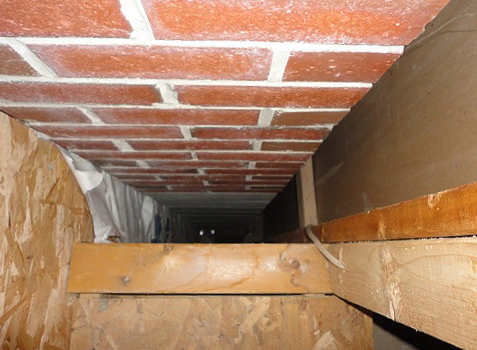
Image Credit: All photos: Erik North
I’m calling this collection of photos The Journal of Poor Homebuilding — kind of like Holmes on Homes, except that I won’t act like the previous contractors ought to be hunted down, predator-style.
I had some other ideas for naming it before settling on JoPH (though they are all the same basic joke): Energy Rearguard, Home Energy Amateurs, Journal of Light Destruction, or the Building Magic Corporation. (As a side note, I love the sites on which these parodies are based and highly recommend reading them).
Unsealed chimney chase
The photo of the chimney chase is taken from above, looking down. This is a gable-end chimney on a Colonial house with a garage addition. There’s a finished room over the garage, so that chimney shaft is surrounded by conditioned interior air.
The chimney was framed in and drywalled. That light you see at the bottom is where the chimney shaft is open into the garage. On the right is uninsulated interior drywall. The cap is entirely unsealed, and the attic is insulated at the floor.
This chimney chase alone probably accounts for 5% (if not more) of the homeowner’s heating bill.
What’s the solution? Treat the top and bottom of the chimney chase as what they are: part of the building envelope. The top and bottom of the chase need to be sealed and insulated.
Moldy bathroom ceiling
Moldy bathroom ceilings are all too common bathroom in cold climates.
The infrared picture shows where the poorly laid fiberglass batts are causing extreme dips in the ceiling surface temperature. The temperature is dipping below the dew point, causing bathroom moisture to condense. leading to surface mold growth. Yummy!
Mold: check. Infrared camera showing why there’s mold: check.
Fireplace flue without a damper
This is a New England classic. So many homes in the northern U.S. predate the development of oil and gas heating; they originally had wood heating. In these homes, chimneys were basically a giant, centrally located thermal mass that helped warm the building.
We’ve seen some of the problems with framing around the chimney. Here’s a photo inside a fireplace flue. This flue was unused and did not have a working damper. It was a wide-open 2-square-foot hole, open year-round. The leak was obvious as hell once the blower door was running, but wasn’t very obvious to the naked eye.
Asbestos-insulated boiler
This isn’t poor home building so much as a former best practice that didn’t turn out. At one time, asbestos was a miracle substance: a great insulator, nearly indestructible in residential applications, and impervious to fire. I mean, stone fibers don’t exactly light with a matchstick.
From an energy history standpoint, this is a neat boiler. Shrouded in asbestos, it is a former coal boiler that was converted first to oil and later to natural gas. Surprisingly, the asbestos is in near-perfect shape, 60 years on.
Unfortunately, many times miracle substances are too good to be true.
An uninsulated room
This photo comes from our friends at Horizon Maine (a home-performance contractor in South Portland) who are doing the weatherization and insulation work at a home where I performed an audit.
This is the space above a porch; the photo was taken after the porch ceiling was removed. There is a sitting room over the porch that the homeowner had set up as a home office. In spite of the efforts of a space heater and furnace going full blast, the temperature in this space wouldn’t get over 50°F in the winter.
Now that the ceiling has been removed, what do we see?
- Sides of sitting room: Uninsulated
- Under the room: Uninsulated
- Second-floor wall (the plaster and lathe on the right): Uninsulated
- Over the room: 4 inches of cellulose with some knob-and-tube wiring for fun.
Dirty fiberglass batt
Oh, attic hatches … One of the most common symptoms of a problematic attic hatch is dirt and dust getting caught in the fiberglass insulation surrounding it. As some auditors say: as an insulation, fiberglass is an excellent air filter.
This photo shows the fiberglass batts surrounding an unsealed and uninsulated attic hatch. Years of excessive air movement has left gobs of crud suspended in the fiberglass fibers.
Erik North, the owner of Free Energy Maine, is an energy auditor and home performance specialist in Westbrook, Maine. He is also the author of the Energy Auditing Blog.
Weekly Newsletter
Get building science and energy efficiency advice, plus special offers, in your inbox.





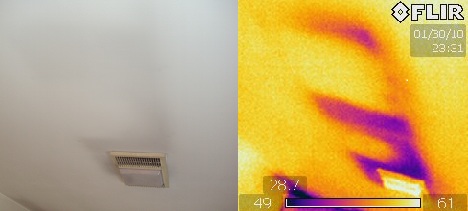
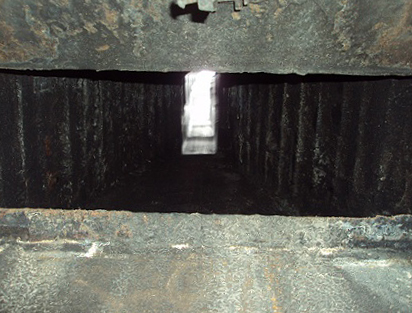

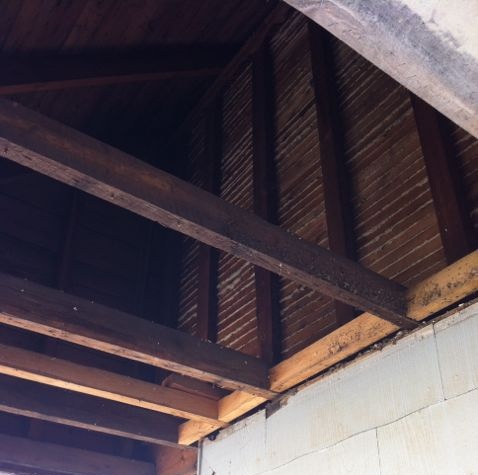


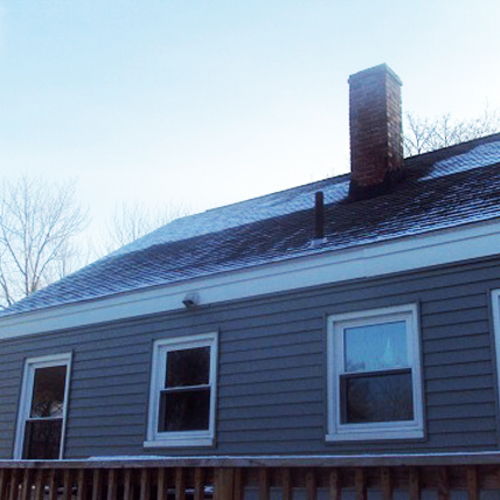
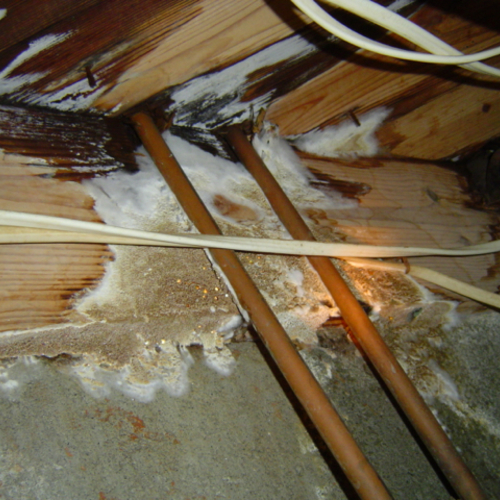
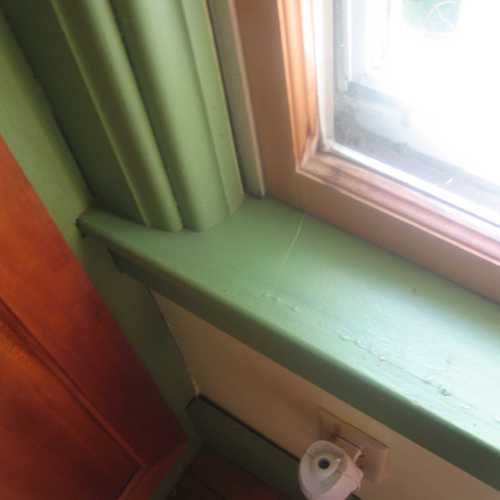






6 Comments
Dirty Fiberglass
What are the concerns about the dirty fiberglass insulation? Would there be any advantange to preventing dust from settling on the fiberglass?
Response to Ron Keagle
Ron,
Erik's views may differ from mine, but here's my opinion: the dust or dirt in the fiberglass isn't really a performance concern. I imagine that the fiberglass batt insulates just as well (or just as badly) when it is dirty as when it is clean.
The dirty fiberglass batt is a clue to air movement, and that's why it is significant. Warm indoor air has been escaping at the perimeter of the attic access hatch for years, and this escaping air carries small dust particles which accumulate in the fiberglass.
So, whenever you see a dirty fiberglass batt in an attic, it's important to identify the air leak and seal it.
Dirt On the Fiberglass
Martin,
I understand your point. The air leak is occurring around the hatch is due to a poorly sealed hatch to the hatch opening. The fiberglass is inconsequential to the air leak. It just happens to be near enough to the airflow to pick up dust being carried by the flowing air.
But, I was a bit curious as to the intended meaning of pointing this out. Mentioning that fiberglass is an air filter does seem to bring the performance of fiberglass into the topic by suggesting that air is flowing though the fiberglass. I was wondering if what is shown and described is meant to suggest that the fiberglass is fully permeated with the type of dirt deposits we see on the outside. If so, I wonder if that is meant to prove that fiberglass does not impede airflow, as is widely believed. But I don’t want to jump to conclusions about what is meant by the photo and comment.
Actually, I am not quite sure what I am seeing in the photo. The dirt appears to be almost black, which makes me wonder if it is not actually mold that has resulted from condensing outward vapor flow accompanying the air leaking out around the hatch.
I have been working on designs for superinsulated houses, and I have put some thought into the issue of dust settling onto open fiberglass batts from the cold-side ventilation in a vaulted ceiling insulation cavity. I have built one such house, and notice that, over time, a considerable amount of dust has settled out of the circulating air and settled on the fiberglass. This dust is simply falling out of the air by gravity. It is not being filtered out of the air and left in the fiberglass due to dusty air being filtered through the fiberglass. I can observe this because the system has scissors trusses with a lot of open space above the insulation.
But the question it raises is whether or not the falling dust penetrates the fiberglass to the point where it fills up the voids to a significant degree. What I see on the top surface of the fiberglass is solid gray. It is maybe a #5 neutral gray appearance. I assume this is all dust carried in by the ventilating air. So a couple days ago, I investigated this closely, and found that the gray dirt is only on the very surface of the fiberglass material. It does not permeate the fiberglass more than 1/16 inch, if that much. And other than that gray surface layer, all of the fiberglass is as bright pink as the day it was installed. So I conclude that the accumulation of dirt settling onto the fiberglass has no detrimental effect.
Response to Ron Keagle
Ron,
All of the phenomena mentioned in your comment sometimes happen. Fiberglass can grow mold, especially when installed in a damp environment (for example, against the interior of a basement wall).
Fiberglass can act as an air filter, accumulating lots of dust, dirt, aerosolized grease, wood smoke, and cigarette smoke; this is common when fiberglass batts are laid on top of unsealed kitchen soffits. Fiberglass can get dusty from above, as you describe. And fiberglass can get dusty from the side, as shown in the photo on this page.
It's up to the investigator to read the clues that fiberglass batts provide and determine what airflow patterns may be contributing to the dust being observed.
Dirty fiberglass
Ron,
I can confirm that it was dirt/dust not mold. I pointed it out as a clue for air drafts, in this case, an extraordinarily dramatic clue.
The hatch was in an unvented bathroom. It seemed that the fiberglass was trapping moisture and dirt. The water was evaporating, leaving behind more dirt than you'd normally expect. There were other signs of a condensation/evaporation cycle (and evaporating before damage set in) in the surrounding attic. With a single occupant/single shower and fairly loose envelope, the moisture was drying quickly.
Leaking attic hatch
Erik,
Thanks for that explanation. I can see the potential for a lot of air and vapor leakage with a poorly sealed attic hatch being in a bathroom. It also looks like there is no vapor barrier in the ceiling. Besides the high humidity, I suppose the bathroom air might reach a higher temperature than the rest of the house at times of bathing. So there would be relatively strong upward convection pushing the air through the loose fitting hatch.
Log in or create an account to post a comment.
Sign up Log in